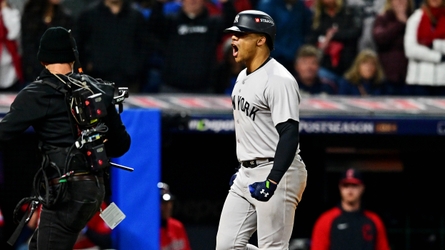PORT ST. LUCIE — Juan Soto does not need the video.
The world’s greatest at-bat artist has agreed to a deep dive on the seven-pitch epic turn at the plate that sent the Yankees to the 2024 World Series — and sealed the Mets and owner Steve Cohen’s desire to sign him.
I’ve come ready with the footage on my phone to jog Soto’s memory. But with a smile and quick shake of his head, Soto launches right into it, obviously seeing the moment as clearly as if he were watching it on television. Geniuses are like that; after all, Paul McCartney can still reconstruct the story of writing “She Loves You” with John on his father’s front porch in 1963.
Soto’s latest masterpiece came on Oct. 19, 2024 in Cleveland. The Yankees were trying to clinch their first American League pennant in 15 years, knotted 2-2 in the 10th inning of a thorny Game 5 of the American League Championship Series.
Soto’s opponent: reliever Hunter Gaddis, an emerging star. The situation: runners on first and second and two outs.
The plan?
Let’s let Soto tell it. He’s as cerebral in baseball conversation as he is vicious in the box.
Stepping into the box
Soto had batted just twice against Gaddis in his life and had not recorded a hit. He knew that Gaddis’ most effective pitch was a slider.
“It’s two outs and [Aaron] Judge behind me,” Soto says. “So I know he’s going to try to attack me and strike me out — to do his best to get me out of the strike zone, get me to chase. Definitely at the beginning… he’s gonna try to attack me. So I was ready for everything.”
First pitch: Slider, 1-0
Gaddis began the at-bat exactly as Soto expected, with a slider. But he missed inside at 89 miles per hour. Soto was not tempted.
“Slider in, first pitch,” he says — and remember, he declined the video reminder; this is all from memory. “He yanked it. I knew that was his best pitch.”
Soto shot a brief glare at Gaddis, then dug his feet back into the dirt.
Second pitch: Slider, 1-1
“Then he threw me another one for a strike,” Soto says.
The pitch was down and a bit away, and just grazed the bottom of the strike zone. Soto’s eye for balls and strikes is better than many umpires’, but he was initially wrong about this one. When home plate umpire Alan Porter made the call, Soto gave a quick shake of his head and bent his knees as if to complain.
Did he think it was a ball?
“In the beginning, yes,” Soto says. “Because I thought it broke a little more than it did. But actually yes, it hit the bottom. That’s when you say, ‘You made a perfect pitch.’”
Third pitch: Slider, 1-2
This was the one that might have ruined the at-bat for Soto. Gaddis offered him a high, hanging slider — and Soto wasted it, able only to foul back the pitch. He understood right away what he had squandered.
“That was his one mistake,” Soto says. “He left it down the middle of the plate, and I fouled it off. Then he never made another mistake. I fouled it straight back and was like, ‘F–k, that was the one. That was the mistake and I missed it.’”
Fourth pitch: Changeup, 1-2
Gaddis followed his worst pitch of the at-bat with his best, a changeup that nearly struck Soto out. But Soto reached it with his bat — barely.
“He threw me that nasty changeup, but I was able to foul it off, thank God,” Soto says. “That was the nastiest pitch he ever threw me through the whole playoffs, I would say. And I fouled it off. Right at the moment I was like [smiles and nods].
Soto remembered his own reaction correctly, too. Immediately after the foul balls, he did indeed nod his head 19 times and allow a wagging tongue to drop from his mouth.
Interlude: Body language
Many batters gather tips and tells from the pitcher’s hands and body: the flaring of the glove when switching to a changeup grip, or a slightly altered hand position for a fastball. But Soto is unique; he looks into a pitcher’s face to see if he appears defeated.
Gaddis did not make it easy on that front, but Soto knew that the latest foul ball changed the entire dynamic between them.
“He was pretty good that he didn’t show too much emotion,” Soto says. “I was looking for the emotions, but he never showed it to me. But definitely I knew in my mind that he threw the best pitch he had and I fouled it off. I was like, ‘He’s done.’”
Fifth pitch: Changeup, 1-2
Gaddis followed his best changeup with a weaker one, elevating it up in the strike zone. Soto fouled it off, his confidence in the ultimate outcome of the at-bat rising even further.
“Then he tried with the changeup again,” Soto says. “He missed. I fouled it off, too. That told me that he doesn’t have the command. I was like, he threw that one, but he didn’t throw a strike. That was two misses. Nobody wants to throw a changeup up.”
Sixth pitch: Slider, 1-2
After failing to get the two changeups past Soto, Gaddis went back to the slider.
“I’m still thinking, hit the ball the other way, stay on it, because his fastball won’t beat me,” Soto says. “He threw me a slider, I fouled it off again. At that moment, I was like, ‘Okay, he showed me the slider three times. I know the motion; I know the speed that he has today.’
“And now at that point, I’m like, you showed me everything you have. There is only one thing you can show me.’”
That one thing?
Seventh pitch: Fastball, home run
Ninety-five miles-per- hour, up and away. Everyone knows what Soto did with it.
Did Soto know that the first fastball of the at-bat was coming on this pitch?
“Yeah,” he says. “I did know a fastball was coming. I was telling myself, ‘I’m all over him. There’s nothing else he can do.’ He threw a fastball, and I just didn’t miss it.
“He threw it right where he wanted it. I was just looking for it.”
The guy watching at home
Mets owner Steve Cohen saw the entire at-bat on TV.
As a sports fan, Cohen recognized in Soto’s “I know I’m gonna beat you” countenance echoes of greats like Michael Jordan. As a world-class art collector, he knew how seldom the opportunity arose to patronize a master.
“When you watch that at-bat, you realize how special he is,” Cohen says now.
Before the year was out, he and the Mets had signed Soto to the largest contract in the history of American professional sports: 15 years, $765 million, and the promise of wonders to come.
Read the full article here



























Discussion about this post